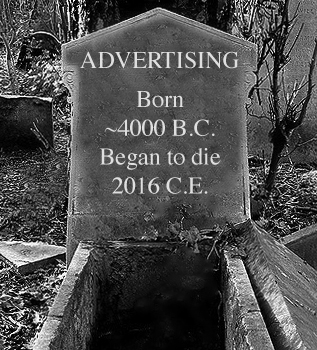 I’m serious.
I’m serious.
Answer this question: Would you pay for any publication that is only advertising? If not, Do you believe advertising adds or subtracts value from the media it funds?
It depends, right? Ads add value to The New Yorker, Vogue, Brides, Guns & Ammo and the Super Bowl. Readers and viewers actually like the ads that show up in those places. In some others, well, kinda. As for the rest? No.
The rest rounds to everything. The italicized items in the paragraph above are exceptions to a rule that is yucky in the extreme, especially on the Web and (increasingly) on our mobile devices.
So let’s say we normalize supply and demand to the Internet, which puts a giant zero — no distance — between everybody and everything. All that should stand between any two entities on the Net are manners, permission and convenience. Any company and any customer should be able to connect with any other, without an intermediary, any time and in any way they both want — provided agreements and methods for doing that are worked out.
So far they aren’t, and that’s the reason we have so much icky advertising on the Web and on our phones: most of the pushers have no manners, and there are no mutually accepted ways to allow or deny permission for being bothered, so those being bothered have responded with ad and tracking blockers. In other words, in the absence of manners, we’ve created an inconvenience.
Naturally, publishers, agencies and ad industry associations are crying foul, but too bad. Blocking that shit reduces friction and feels good. (Thank you, Bob Garfield, for both of those.)
What we need next are better ways for demand and supply to inform and connect. Not just better ways to pay for media. (That would be nice, but media have mostly been a one-way channel for informing, and at best a secondary way to connect.)
Think about what will happen to markets when any one of us can intentcast our needs for products or services, and do so easily and in standard ways that any supplier can understand. Then think about what will happen when any company can inform existing or potential customers directly, without the intermediation of the media we know today — and with clear and well-understood permissions for doing that on both sides.
The result will be the intention economy, which will work far better for demand and supply than the attention economy we have today, simply because there will be so many more and better ways to inform and connect, in both directions.
Asking today’s media to give us the intention economy is like asking AM radio to give us cellular telephony.
They can’t, and they won’t. At best they’ll serve the remaining needs of the attention economy: namely, old-fashioned Madison Avenue type branding, like we get from the best ads in the Super Bowl and in your better print magazines. This is the wheat I talk about in Separating Advertising’s Wheat and Chaff, and that Don Marti calls “signalful” advertising. Maybe that stuff will be with us forever. For the sake of the good things they fund, I hope so.
But I don’t know, because I’m sure if we zero-base the intention economy in our new all-digital world, it is unlikely that we’ll invent any of the media we have today.
It would be easy to call the intention economy utopian hogwash, and I expect some comments to say as much. But one could have said the same thing about personal computing in 1973, the Internet in 1983 and smartphones in 1993. All of those were unthinkable at those points in history, yet inevitable in retrospect.
The fact is, we are now in a digital world as well as an analog one. That alone rewrites the future in a huge way. Digital itself is the only medium, and the whole environment. It’s also us, whether we like it or not. We are digital as well as cellular.
In the past we put up with being annoyed and yelled at by advertising. And now we’re putting up with being spied on and guessed at, personally, as well. But we don’t have to put up with any of it any more. That’s another thing digital life makes possible, even if we haven’t taken the measures yet. The limits of invention are a lot farther out on the Giant Zero than they ever were in the old analog world where today’s media — including digital ones following analog models — were born.
Advertising is an analog thing. The arguments for its survival in the digital world need to be ones that start with demand. Is it something we want? Because we’ll get what we want. Sooner or later, we’ll have the digital versions of clothing and shelter (aka privacy), of terms and permissions, of ways to signal our intentions. If advertising fits in there somewhere, great. If not, R.I.P.
